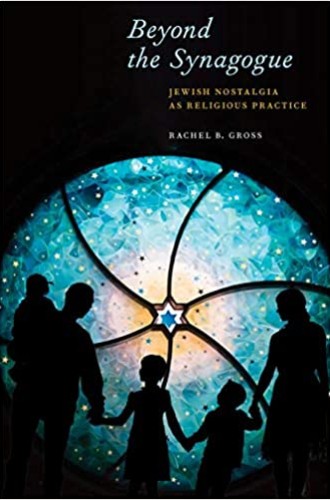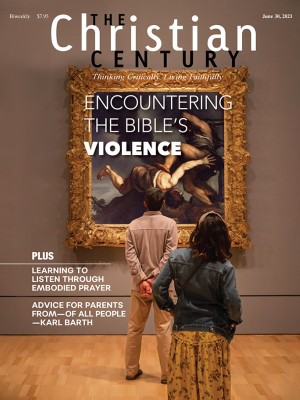Rachel Gross wants to blur the distinction between Jewish culture and Jewish religion
Being Jewish goes beyond the synagogue.
This book, part of the North American Religions series from New York University Press, tells the story of our religious present and future. In fact, I would argue that what the author says about American Judaism is also largely true in American Catholicism.
Rachel B. Gross, who teaches American Jewish studies at San Francisco State University, wants to make clear that there are ways of being Jewish “beyond the synagogue” and that these ways are just as Jewish as practicing Judaism is. With a smart analysis of contemporary culture, sociology, urban studies, and religion, she makes her point clearly and well, with cogent examples.
Read our latest issue or browse back issues.
Beyond the Synagogue opens with an anecdote of a tour of the Eldridge Street Synagogue on New York’s Lower East Side, where a once-vibrant shul for Eastern European immigrants has, since 2007, been a museum. Gross then states her thesis:
American Jews participate in a broad array of ostensibly nonreligious activities—including visiting Jewish historic sites, conducting genealogical research, purchasing books and toys that teach Jewish nostalgia to children, and seeking out traditional Jewish foods—that are properly understood as religious.
She explains that she wants to blur the distinction often made “between Jewish culture and Jewish religion” since “Jews create individual and communal meaning in their lives” in cultural ways as much as or more than in religious ones. When I looked at the book’s index, I noticed that “Passover” has six page references, and “pastrami” also has six.
Gross writes, “I use the term nostalgia as a way to engage and complicate conversations about Jewish memory, history, and heritage, popular accounts of the past that give it meaning in the present.” For many Jewish people and organizations, she continues, “nostalgia bridges historical scholarship and social memory. It is both an individual feeling and a shared practice.”
To me, the word nostalgia implies a measure of superficiality in remembrance. Gross seems aware of this concern: she spends quite a bit of time defending nostalgia as more than sentimentality. Although at one point she characterizes nostalgia as “a wishful affection or sentimental longing for an irrevocable past,” she also wants to define it more broadly. “Institutions such as museums and restaurants make nostalgia a consumable product as well as an emotion and a religious practice, while popular culture and public history function as religious objects and sites.”
As a Catholic who’s married to a congregational rabbi and raising a Jewish child, I’ve learned that there are many ways of being Jewish. Still, based on my experiences in synagogue and in Jewish homes, I can’t help but feel that Gross draws too stark a line between the Jewish nostalgia she detects and the function of memory that has always been essential to Judaism.
Consider, for example, the rituals around Passover. The Haggadah is clear about why Jews are to observe Passover each year: to tell the story. The word haggadah means “narrative,” and it is a mitzvot, a commandment, to tell the story of the exodus to your children. Printed haggadot are the most common Jewish books in the world, and Passover is the most observed of holidays.
I think there’s a more natural continuity between the religious and nonreligious than Gross lets on. She finds various forms of nostalgia in the Eldridge Street Synagogue tour, including the eating of certain foods and invitations for the tour guests to imagine themselves praying as the synagogue’s original European immigrant members did. These rituals, each in their own way, exemplify how “the fulfillment of the mitzvah of nostalgia is a central aspect of American Jewish religion.”
But Gross doesn’t seem to see the continuity between these ways of “meaning-making” (a phrase she often uses) and other millennia-old religious rituals such as the Seder or reciting the Kaddish prayer. Isn’t the nostalgia she locates in genealogies and souvenir tchotchkes a meaningful extension of the Jewish use of memory?
Judaism as we know it, since the early years of the Common Era, has been about narrative and teaching that involve remembering. The central prayer of Jewish liturgy, the Amidah, begins with praising God—not for God’s attributes, but as the God “of Abraham, Isaac, and Jacob” (and, in progressive synagogues, also “of Sarah, Rebekah, Rachel, and Leah”). The way into Jewish prayer is by remembering.
And recall what the Dalai Lama chose to ask rabbis from the United States when they visited him in Dharamshala in 1990. Rodger Kamenetz tells the story of this fascinating encounter in The Jew in the Lotus. The Dalai Lama had lived through a half century of the Chinese government attempting to erase his Tibetan religion. He said to the rabbis: “Tell me your secret, the secret of Jewish spiritual survival in exile.” Survival depends on remembering.
Still, I find the thesis of Beyond the Synagogue to be illuminating as a way of thinking about religion in the United States and in the West generally. I’d like to see my coreligionists in the Roman Catholic tradition take it up. As service attendance continues its decline, memory will become more important. Will wise religious leaders find new ways to incorporate remembered lessons and occasions into new forms of religious observance?






